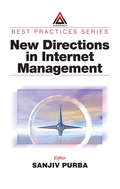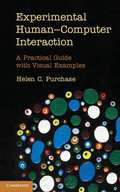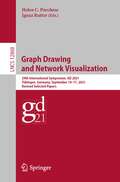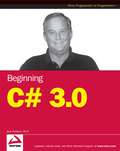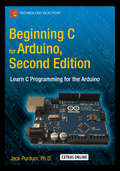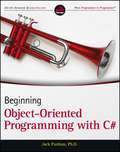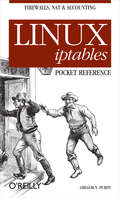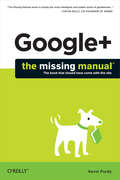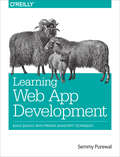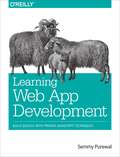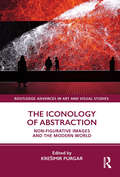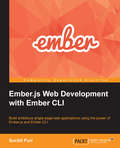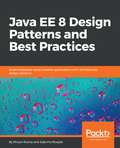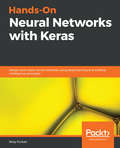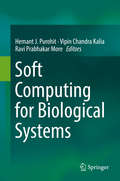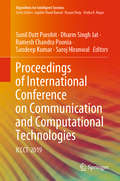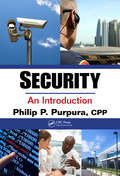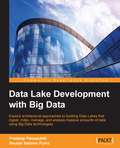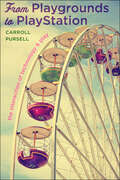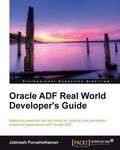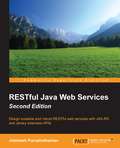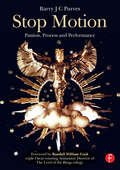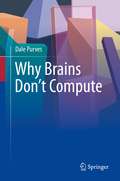- Table View
- List View
New Directions in Internet Management (Best Practices Ser.)
by Sanjiv PurbaWhat is the business model for making money on the Internet and how does it function? The answer to this question will determine the shape of the Internet over the near term. As the Internet business model continues to evolve, so will Internet management. And with the demise of the Internet greatly exaggerated, it will continue to be a driving forc
Experimental Human-Computer Interaction
by Helen C. PurchaseExperiments that require the use of human participants are time consuming and costly: it is important to get the process right the first time. Planning and preparation are key to success. This practical book takes the human-computer interaction researcher through the complete experimental process, from identifying a research question to designing and conducting an experiment, and then to analysing and reporting the results. The advice offered in this book draws on the author's twenty years of experience running experiments. In describing general concepts of experimental design and analysis she refers to numerous worked examples that address the very real practicalities and problems of conducting an experiment, such as managing participants, getting ethical approval, pre-empting criticism, choosing a statistical method and dealing with unexpected events.
Graph Drawing and Network Visualization: 29th International Symposium, GD 2021, Tübingen, Germany, September 14–17, 2021, Revised Selected Papers (Lecture Notes in Computer Science #12868)
by Helen C. Purchase Ignaz RutterThis book constitutes the proceedings of the 28th International Symposium on Graph Drawing and Network Visualization, GD 2021, which was held in Tübingen, Germany, during September 14-17, 2021.The 23 full papers and 5 short papers presented in these proceedings were carefully reviewed and selected from 74 submissions. The abstracts of 13 posters presented at the conference can be found in the back matter of the volume. The contributions were organized in topical sections as follows: Best Paper (Track 1: Combinatorial and Algorithmic Aspects); Best Paper (Track 2: Experimental, Applied, and Network Visualization Aspects); Crossing Minimization and Beyond-Planarity; Morphing and Graph Abstraction; Geometric Constraints; Topological and Upward Drawings; Linear Layouts; Contact and Visibility Representations; Geometric Aspects in Graph Drawing; AI applications; and Graph Drawing Contest Report.
Beginning C# 3.0
by Jack PurdumLearn all the basics of C# 3.0 from Beginning C# 3.0: An Introduction to Object Oriented Programming, a book that presents introductory information in an intuitive format. If you have no prior programming experience but want a thorough, easy-to-understand introduction to C# and Object Oriented Programming, this book is an ideal guide. Using the tutorials and hands-on coding examples, you can discover tried and true tricks of the trade, understand design concepts, employ debugging aids, and design and write C# programs that are functional and that embody safe programming practices.
Beginning C for Arduino: Learn C Programming for the Arduino
by Jack PurdumBeginning C for Arduino, Second Edition is written for those who have no prior experience with microcontrollers or programming but would like to experiment and learn both. Updated with new projects and new boards, this book introduces you to the C programming language, reinforcing each programming structure with a simple demonstration of how you can use C to control the Arduino family of microcontrollers. Author Jack Purdum uses an engaging style to teach good programming techniques using examples that have been honed during his 25 years of university teaching. Beginning C for Arduino, Second Edition will teach you: The C programming language How to use C to control a microcontroller and related hardware How to extend C by creating your own libraries, including an introduction to object-oriented programming During the course of the book, you will learn the basics of programming, such as working with data types, making decisions, and writing control loops. You'll then progress onto some of the trickier aspects of C programming, such as using pointers effectively, working with the C preprocessor, and tackling file I/O. Each chapter ends with a series of exercises and review questions to test your knowledge and reinforce what you have learned. What you'll learn The syntax of the C programming language as defined for the Arduino Tried and true coding practices (applicable to any programming language) How to design, code, and debug programs that drive Arduino microcontrollers How to extend the functionality of C How to integrate low cost, off-the-shelf, hardware shields into your own projects Who this book is for The book is aimed at a complete novice with no programming background. It assumes no prior programming or hardware design experience and is written for creative and curious people who would like to blend a software and hardware learning experience into a single, enjoyable endeavor. Table of Contents Introduction to Arduino Microcontrollers Arduino C Data Types Decision Making in C Program Loops Functions in C Storage Classes and Scope Introduction to Pointers Using Pointers Effectively I/O Operations The C Preprocessor A Gentle Introduction to Object-Oriented Programming Arduino Libraries Arduino I/O Appendix A - Suppliers Appendix B - Hardware Components
Beginning Object-Oriented Programming with C#
by Jack PurdumThe ideal beginner's guide to C# and object-oriented programmingWrox beginners' guides have the perfect formula for getting programming newcomers up and running. This one introduces beginners to object-oriented programming using C# to demonstrate all of the core constructs of this programming framework. Using real-world situations, you'll discover how to create, test, and deliver your programs and how to work with classes, arrays, collections, and all the elements of object-oriented programming.Covers exactly what beginners, even those with no prior programming experience, need to know to understand object-oriented programming and start writing programs in C# Explains the advantages and disadvantages of C#, and tips for understanding C# syntax Explores properties, encapsulation, and classes; value data types; operands and operators; errors and debugging; variables; and reference types Shows how to use statement repetition and program loops, understand arrays and collections, and write your own classes Also covers inheritance and polymorphismBeginning Object-Oriented Programming with C# uses the tried-and-true Wrox formula for making this popular programming method easy to learn.
Linux iptables Pocket Reference
by Gregor N. PurdyFirewalls, Network Address Translation (NAT), network logging and accounting are all provided by Linux's Netfilter system, also known by the name of the command used to administer it, iptables. The iptables interface is the most sophisticated ever offered on Linux and makes Linux an extremely flexible system for any kind of network filtering you might do. Large sets of filtering rules can be grouped in ways that makes it easy to test them and turn them on and off. Do you watch for all types of ICMP traffic--some of them quite dangerous? Can you take advantage of stateful filtering to simplify the management of TCP connections? Would you like to track how much traffic of various types you get? This pocket reference will help you at those critical moments when someone asks you to open or close a port in a hurry, either to enable some important traffic or to block an attack. The book will keep the subtle syntax straight and help you remember all the values you have to enter in order to be as secure as possible. The book has an introductory section that describes applications,followed by a reference/encyclopaedic section with all the matches and targets arranged alphabetically.
Google+: The Missing Manual
by Kevin PurdyIf you want to gain more control over your social networking activities with Google+, this jargon-free guide helps you quickly master the ins and outs of the site. Learn how to organize your contacts, hold video chats with as many as ten people, and determine exactly who may learn what about you. With this book, you'll navigate Google+ with ease. The important stuff you need to know Massage your profile. Control what the public, specific groups, or certain individuals can see about you. Move in the right circles. Assign folks to different groups and share the right stuff with the right people. Jump into streams. Get all the updates, pictures, and links from people you know. Host hangouts. Organize and attend group video chats. View and share photos. Make them available to whomever you like--whether or not they're Google+ members. Get notifications. Monitor what others do (and share about you) on Google+. Go mobile. Use Google+ on your Android, iPhone, or mobile web browser.
Google+: The Missing Manual (Oreilly And Associate Ser.)
by Kevin PurdyIf you want to gain more control over your social networking activities with Google+, this jargon-free guide helps you quickly master the ins and outs of the site. Learn how to organize your contacts, hold video chats with as many as ten people, and determine exactly who may learn what about you. With this book, you’ll navigate Google+ with ease.The important stuff you need to knowMassage your profile. Control what the public, specific groups, or certain individuals can see about you.Move in the right circles. Assign folks to different groups and share the right stuff with the right people.Jump into streams. Get all the updates, pictures, and links from people you know.Host hangouts. Organize and attend group video chats.View and share photos. Make them available to whomever you like—whether or not they’re Google+ members.Get notifications. Monitor what others do (and share about you) on Google+.Go mobile. Use Google+ on your Android, iPhone, or mobile web browser.
Learning Web App Development
by Semmy PurewalGrasp the fundamentals of web application development by building a simple database-backed app from scratch, using HTML, JavaScript, and other open source tools. Through hands-on tutorials, this practical guide shows inexperienced web app developers how to create a user interface, write a server, build client-server communication, and use a cloud-based service to deploy the application.Each chapter includes practice problems, full examples, and mental models of the development workflow. Ideal for a college-level course, this book helps you get started with web app development by providing you with a solid grounding in the process.Set up a basic workflow with a text editor, version control system, and web browserStructure a user interface with HTML, and include styles with CSSUse JQuery and JavaScript to add interactivity to your applicationLink the client to the server with AJAX, JavaScript objects, and JSONLearn the basics of server-side programming with Node.jsStore data outside your application with Redis and MongoDBShare your application by uploading it to the cloud with CloudFoundryGet basic tips for writing maintainable code on both client and server
Learning Web App Development: Build Quickly with Proven JavaScript Techniques
by Semmy PurewalGrasp the fundamentals of web application development by building a simple database-backed app from scratch, using HTML, JavaScript, and other open source tools. Through hands-on tutorials, this practical guide shows inexperienced web app developers how to create a user interface, write a server, build client-server communication, and use a cloud-based service to deploy the application.Each chapter includes practice problems, full examples, and mental models of the development workflow. Ideal for a college-level course, this book helps you get started with web app development by providing you with a solid grounding in the process.Set up a basic workflow with a text editor, version control system, and web browserStructure a user interface with HTML, and include styles with CSSUse JQuery and JavaScript to add interactivity to your applicationLink the client to the server with AJAX, JavaScript objects, and JSONLearn the basics of server-side programming with Node.jsStore data outside your application with Redis and MongoDBShare your application by uploading it to the cloud with CloudFoundryGet basic tips for writing maintainable code on both client and server
Learning Web App Development
by Semmy PurewalGrasp the fundamentals of web application development by building a simple database-backed app from scratch, using HTML, JavaScript, and other open source tools. Through hands-on tutorials, this practical guide shows inexperienced web app developers how to create a user interface, write a server, build client-server communication, and use a cloud-based service to deploy the application. Each chapter includes practice problems, full examples, and mental models of the development workflow. Ideal for a college-level course, this book helps you get started with web app development by providing you with a solid grounding in the process. Set up a basic workflow with a text editor, version control system, and web browser Structure a user interface with HTML, and include styles with CSS Use JQuery and JavaScript to add interactivity to your application Link the client to the server with AJAX, JavaScript objects, and JSON Learn the basics of server-side programming with Node. js Store data outside your application with Redis and MongoDB Share your application by uploading it to the cloud with CloudFoundry Get basic tips for writing maintainable code on both client and server
The Iconology of Abstraction: Non-figurative Images and the Modern World (Routledge Advances in Art and Visual Studies)
by Krešimir PurgarThis book uncovers how we make meaning of abstraction, both historically and in present times, and examines abstract images as a visual language. The contributors demonstrate that abstraction is not primarily an artistic phenomenon, but rather arises from human beings’ desire to imagine, understand and communicate complex, ineffable concepts in fields ranging from fine art and philosophy to technologies of data visualization, from cartography and medicine to astronomy. The book will be of interest to scholars working in image studies, visual studies, art history, philosophy and aesthetics.
Ember.js Web Development with Ember CLI
by Suchit PuriIf you are a JavaScript developer who is starting out to build ambitious Ember.js application, or a developer who has prior Ember.js experience and want to transition your application to the latest Ember.js version with Ember CLI, then this book is for you.
Java EE 8 Design Patterns and Best Practices: Build enterprise-ready scalable applications with architectural design patterns
by João Purificação Rhuan RochaGet the deep insights you need to master efficient architectural design considerations and solve common design problems in your enterprise applications.Key FeaturesThe benefits and applicability of using different design patterns in JAVA EE Learn best practices to solve common design and architectural challengesChoose the right patterns to improve the efficiency of your programs Book DescriptionPatterns are essential design tools for Java developers. Java EE Design Patterns and Best Practices helps developers attain better code quality and progress to higher levels of architectural creativity by examining the purpose of each available pattern and demonstrating its implementation with various code examples. This book will take you through a number of patterns and their Java EE-specific implementations.In the beginning, you will learn the foundation for, and importance of, design patterns in Java EE, and then will move on to implement various patterns on the presentation tier, business tier, and integration tier. Further, you will explore the patterns involved in Aspect-Oriented Programming (AOP) and take a closer look at reactive patterns. Moving on, you will be introduced to modern architectural patterns involved in composing microservices and cloud-native applications. You will get acquainted with security patterns and operational patterns involved in scaling and monitoring, along with some patterns involved in deployment.By the end of the book, you will be able to efficiently address common problems faced when developing applications and will be comfortable working on scalable and maintainable projects of any size.What you will learnImplement presentation layers, such as the front controller patternUnderstand the business tier and implement the business delegate patternMaster the implementation of AOPGet involved with asynchronous EJB methods and REST servicesInvolve key patterns in the adoption of microservices architectureManage performance and scalability for enterprise-level applicationsWho this book is forJava developers who are comfortable with programming in Java and now want to learn how to implement design patterns to create robust, reusable and easily maintainable apps.
Hands-On Neural Networks with Keras: Design and create neural networks using deep learning and artificial intelligence principles
by Niloy PurkaitYour one-stop guide to learning and implementing artificial neural networks with Keras effectively Key Features Design and create neural network architectures on different domains using Keras Integrate neural network models in your applications using this highly practical guide Get ready for the future of neural networks through transfer learning and predicting multi network models Book Description Neural networks are used to solve a wide range of problems in different areas of AI and deep learning. Hands-On Neural Networks with Keras will start with teaching you about the core concepts of neural networks. You will delve into combining different neural network models and work with real-world use cases, including computer vision, natural language understanding, synthetic data generation, and many more. Moving on, you will become well versed with convolutional neural networks (CNNs), recurrent neural networks (RNNs), long short-term memory (LSTM) networks, autoencoders, and generative adversarial networks (GANs) using real-world training datasets. We will examine how to use CNNs for image recognition, how to use reinforcement learning agents, and many more. We will dive into the specific architectures of various networks and then implement each of them in a hands-on manner using industry-grade frameworks. By the end of this book, you will be highly familiar with all prominent deep learning models and frameworks, and the options you have when applying deep learning to real-world scenarios and embedding artificial intelligence as the core fabric of your organization. What you will learn Understand the fundamental nature and workflow of predictive data modeling Explore how different types of visual and linguistic signals are processed by neural networks Dive into the mathematical and statistical ideas behind how networks learn from data Design and implement various neural networks such as CNNs, LSTMs, and GANs Use different architectures to tackle cognitive tasks and embed intelligence in systems Learn how to generate synthetic data and use augmentation strategies to improve your models Stay on top of the latest academic and commercial developments in the field of AI Who this book is for This book is for machine learning practitioners, deep learning researchers and AI enthusiasts who are looking to get well versed with different neural network architecture using Keras. Working knowledge of Python programming language is mandatory.
Soft Computing for Biological Systems
by Hemant J. Purohit Vipin Chandra Kalia Ravi Prabhakar MoreThis book explains how the biological systems and their functions are driven by genetic information stored in the DNA, and their expression driven by different factors. The soft computing approach recognizes the different patterns in DNA sequence and try to assign the biological relevance with available information.The book also focuses on using the soft-computing approach to predict protein-protein interactions, gene expression and networks. The insights from these studies can be used in metagenomic data analysis and predicting artificial neural networks.
Proceedings of International Conference on Communication and Computational Technologies: ICCCT-2019 (Algorithms for Intelligent Systems)
by Sunil Dutt Purohit Dharm Singh Jat Ramesh Chandra Poonia Sandeep Kumar Saroj HiranwalThis book offers a collection of high-quality peer-reviewed research papers presented at the Second International Conference on Communication and Computational Technologies (ICCCT 2019), held at Rajasthan Institute of Engineering and Technology, Jaipur, Rajasthan, India, on 30–31 August 2019. In contributions prepared by researchers from academia and industry alike, the book discusses a wide variety of industrial, engineering and scientific applications of emerging techniques.
Security: An Introduction
by Philip P. PurpuraToday, threats to the security of an organization can come from a variety of sources- from outside espionage to disgruntled employees and internet risks to utility failure. Reflecting the diverse and specialized nature of the security industry, Security: An Introduction provides an up-to-date treatment of a topic that has become increasingly comple
Data Lake Development with Big Data
by Beulah Salome Purra Pradeep PasupuletiExplore architectural approaches to building Data Lakes that ingest, index, manage, and analyze massive amounts of data using Big Data technologies About This Book * Comprehend the intricacies of architecting a Data Lake and build a data strategy around your current data architecture * Efficiently manage vast amounts of data and deliver it to multiple applications and systems with a high degree of performance and scalability * Packed with industry best practices and use-case scenarios to get you up-and-running Who This Book Is For This book is for architects and senior managers who are responsible for building a strategy around their current data architecture, helping them identify the need for a Data Lake implementation in an enterprise context. The reader will need a good knowledge of master data management, information lifecycle management, data governance, data product design, data engineering, and systems architecture. Also required is experience of Big Data technologies such as Hadoop, Spark, Splunk, and Storm. What You Will Learn * Identify the need for a Data Lake in your enterprise context and learn to architect a Data Lake * Learn to build various tiers of a Data Lake, such as data intake, management, consumption, and governance, with a focus on practical implementation scenarios * Find out the key considerations to be taken into account while building each tier of the Data Lake * Understand Hadoop-oriented data transfer mechanism to ingest data in batch, micro-batch, and real-time modes * Explore various data integration needs and learn how to perform data enrichment and data transformations using Big Data technologies * Enable data discovery on the Data Lake to allow users to discover the data * Discover how data is packaged and provisioned for consumption * Comprehend the importance of including data governance disciplines while building a Data Lake In Detail A Data Lake is a highly scalable platform for storing huge volumes of multistructured data from disparate sources with centralized data management services. It eliminates the need for up-front modeling and rigid data structures by allowing schema-less writes. Data Lakes make it possible to ask complex far-reaching questions to find out hidden data patterns and relationships. This book explores the potential of Data Lakes and explores architectural approaches to building data lakes that ingest, index, manage, and analyze massive amounts of data using batch and real-time processing frameworks. It guides you on how to go about building a Data Lake that is managed by Hadoop and accessed as required by other Big Data applications such as Spark, Storm, Hive, and so on, to create an environment in which data from different sources can be meaningfully brought together and analyzed. Data Lakes can be viewed as having three capabilities--intake, management, and consumption. This book will take readers through each of these processes of developing a Data Lake and guide them (using best practices) in developing these capabilities. It will also explore often ignored, yet crucial considerations while building Data Lakes, with the focus on how to architect data governance, security, data quality, data lineage tracking, metadata management, and semantic data tagging. By the end of this book, you will have a good understanding of building a Data Lake for Big Data. You will be able to utilize Data Lakes for efficient and easy data processing and analytics. Style and approach Data Lake Development with Big Data provides architectural approaches to building a Data Lake. It follows a use case-based approach where practical implementation scenarios of each key component are explained. It also helps you understand how these use cases are implemented in a Data Lake. The chapters are organized in a way that mimics the sequential data flow evidenced in a Data Lake.
From Playgrounds to PlayStation: The Interaction of Technology and Play
by Carroll PursellHow technology shapes play in America—and vice versa.In this romp through the changing landscape of nineteenth- and twentieth-century American toys, games, hobbies, and amusements, senior historian of technology Carroll Pursell poses a simple but interesting question: What can we learn by studying the relationship between technology and play? From Playgrounds to PlayStation explores how play reflects and drives the evolution of American culture. Pursell engagingly examines the ways in which technology affects play and play shapes people. The objects that children (and adults) play with and play on, along with their games and the hobbies they pursue, can reinforce but also challenge gender roles and cultural norms. Inventors—who often talk about "playing" at their work, as if motivated by the pure fun of invention—have used new materials and technologies to reshape sports and gameplay, sometimes even crafting new, extreme forms of recreation, but always responding to popular demand.Drawing from a range of sources, including scholarly monographs, patent records, newspapers, and popular and technical journals, the book covers numerous modes and sites of play. Pursell touches on the safety-conscious playground reform movement, the dazzling mechanical innovations that gave rise to commercial amusement parks, and the media's colorful promotion of toys, pastimes, and sporting events. Along the way, he shows readers how technology enables the forms, equipment, and devices of play to evolve constantly, both reflecting consumer choices and driving innovators and manufacturers to promote toys that involve entirely new kinds of play—from LEGOs and skateboards to beading kits and videogames.
Oracle ADF Real World Developer’s Guide
by Jobinesh PurushothamanThis book is written in simple, easy to understand format with lots of screenshots and step-by-step explanations,If you are an ADF developer looking forward to building healthy and better performing applications using Oracle ADF, then this is the best guide for you. You need to be proficient with Java and ADF before getting started with this book.
RESTful Java Web Services - Second Edition
by Jobinesh PurushothamanDesign scalable and robust RESTful web services with JAX-RS and Jersey extension APIs About This Book * Get to grips with the portable Java APIs used for JSON processing * Design solutions to produce, consume, and visualize RESTful web services using WADL, RAML, and Swagger * A step-by-step guide packed with many real-life use-cases to help you build efficient and secure RESTful web APIs in Java Who This Book Is For If you are a web developer with a basic understanding of the REST concepts but are new to the idea of designing and developing RESTful web services, this is the book for you. As all the code samples for the book are written in Java, proficiency in Java is a must. What You Will Learn * Introduce yourself to the RESTful software architectural style and the REST API design principles * Make use of the JSR 353 APIs and Jackson API for JSON processing * Build portable RESTful web APIs, making use of the JAX-RS 2.0 API * Simplify API development using the Jersey extension APIs * Secure your RESTful web services with various authentication and authorization mechanisms * Get to grips with the various metadata solutions to describe, produce, and consume RESTful web services * Understand the design and coding guidelines to build well-performing RESTful APIs * See how the role of RESTful web services changes with emerging technologies and trends In Detail REST (REpresentational State Transfer) is a simple yet powerful software architecture style to create scalable web services and allow them to be simple, lightweight, and fast. The REST API uses HTTP and JSON, so that it can be used with many programming languages such as Ruby, Java, Python, and Scala. Its use in Java seems to be the most popular though, because of the API's reusability. This book is a guide to developing RESTful web services in Java using the popular RESTful framework APIs available today. You will begin with gaining an in-depth knowledge of the RESTful software architectural style and its relevance in modern applications. Further, you will understand the APIs to parse, generate, transform, and query JSON effectively. Then, you will see how to build a simple RESTful service using the popular JAX-RS 2.0 API along with some real-world examples. This book will introduce you to the Jersey framework API, which is used to simplify your web services. You will also see how to secure your services with various authentication mechanisms. You will get to grips with various solutions to describe, produce, consume, and visualize RESTful web services. Finally, you will see how to design your web services to equip them for the future technological advances, be it Cloud or mobile computing. By the end of this book, you will be able to efficiently build robust, scalable, and secure RESTful web services, making use of the JAX-RS and Jersey framework extensions. Style and approach This book is written as a step-by-step guide to designing and developing robust RESTful web services. Each topic is explained in a simple and easy-to-understand manner with lots of real-life use-cases and their solutions.
Stop Motion: Passion, Process and Performance
by Barry J PurvesBe inspired by award-winning animator Barry Purves' honest insight into the creative process of making stop motion animations, using his own classic films to illustrate every step along the way. With Barry's enthusiasm for puppets in all their many guises and in-depth interviews from some of the world's other leading practitioners, there is advice, inspiration and entertainment galore in Stop Motion: Passion, Process and Performance. And there's more! Many of the artists and craftsmen interviewed have contributed their own specially drawn illustrations - showing their inspirations, heroes and passion for their craft. These beautiful images help make the book a truly personal journey into the heart of the animation industry with broad appeal for anyone with a love of animation.
Why Brains Don't Compute
by Dale PurvesThis book examines what seems to be the basic challenge in neuroscience today: understanding how experience generated by the human brain is related to the physical world we live in. The 25 short chapters present the argument and evidence that brains address this problem on a wholly trial and error basis. The goal is to encourage neuroscientists, computer scientists, philosophers, and other interested readers to consider this concept of neural function and its implications, not least of which is the conclusion that brains don’t “compute.”
